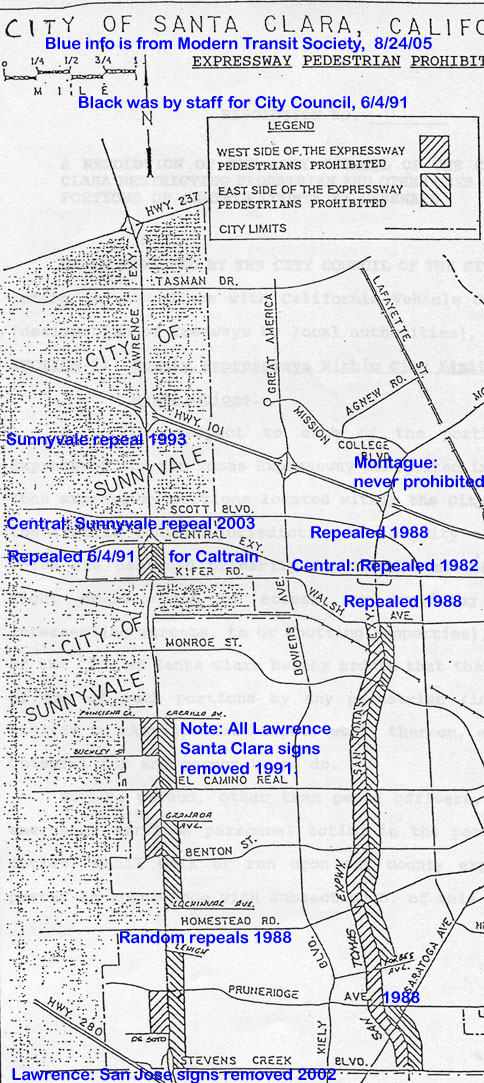Modern Transit Society
P.O. Box 5582, San Jose CA 95150 408 221-0694
August 29, 2005
Councilmember Jamie Matthews
City of Santa Clara
Subject: Request to Repeal Resolution 5603 –prohibition of pedestrians
Dear Councilmember Matthews,
[Historical portion is below, other portions are in the San Tomas Expressway page.]
A map and photo from Lawrence Expressway shows my actual situation, where I was given a ticket in 1987 for not using a car to go to
the nearest supermarket, Cosentinos, and not taking a half-mile detour which would be an irrational act, forced only
upon non-motorists.
There was a separate battle to allow Lawrence Caltrain patrons —one of them was my brother —to use the pedestrian
underpass crossing under Central at Lawrence. Half of these transit patrons jay-walked across Central to avoid ticketing by police
for walking past “pedestrians prohibited” signs at the underpass. The other half used the underpass but risked ticketing
to avoid the danger of jay-walking. The (then) City traffic engineer’s solution was a one mile walking detour, and he vigorously
opposed use of the pedestrian underpass because the County planned to destroy the underpass when adding lanes —several years
later. Fortunately, the Council repealed the prohibition here at our request on June 4, 1991, and the underpass was saved by our
subsequent effort.*
The large map [see at bottom or click here] shows a history of repeals in boldface, including adjacent cities, at our efforts and that of the Silicon
Valley Bicycle Coalition (then called Santa Clara Valley Bicycle Association). The boldface is overlaid on the
bicycle-pedestrian prohibitory map of the City from 1988 to 1991. In 1988, the Council repealed prohibitions where State law
protected rights of non-motorists, including where I was ticketed on San Tomas and forced to pay a $126 fine. I forced removal of
illegal prohibitory signs but was never refunded for the wrongful conviction due to a clause added to the City’s resolution.
Today, only portions of San Tomas and two miles of Foothill in Palo Alto —which will repeal soon— still have pedestrians
prohibited.
MTS forced the County highway engineers to construct sidewalks on Lawrence, at least on one side, for the length of Santa Clara in
1997** and Sunnyvale in 1993 —at no cost to the cities —when County highway engineers tried to force people to walk and
bicycle in the 50 mph traffic lane when adding more lanes. The sidewalks of Lawrence were not on the original engineering
blueprints which I examined circa 1990. I learned from those blueprints that the County highway engineers’ repeated statement
to elected officials that “There is no room for bicycles and pedestrians after adding lanes.” was simply a ploy in their
attempt to not use a penny of their project money for relocating bicycle and pedestrian facilities —8-foot wide shoulders.
Their statements are proven false today by the sidewalks and by the shoulders meeting bike-lane specifications.
Sidewalks will not be similarly constructed on San Tomas Expressway unless the Council
repeals the prohibition of pedestrians before additional lanes, already planned, are added.***
Since the last Council action to allow bicycles (May 28, 1991) and to allow Caltrain patrons (June 4, 1991) on expressways, there
have been new laws and policies supporting pedestrians. Most importantly, the County Expressway Plan [Master Plan] specifically
supports pedestrian use of shoulders of San Tomas Expressway, and was endorsed by the City on May 20, 2003. Please see a list of
policies and laws violated by City Resolution 5603, either attached or at this web page which has links to sources:
moderntransit.org/expy/st.html
Sincerely,
Akos Szoboszlay
President
* The pedestrian underpass was actually destroyed but then reconstructed, and access was blocked for about one year.
** In 1995, the shoulders were turned into traffic lanes, forcing walkers and bicyclists to use the 50 mph traffic lane.
Sidewalks were constructed in 1997. Shoulders (5 feet) were subsequently restored for bicycles and recently widened to 6 feet.
This width also enables disabled vehicle parking.
*** The pedestrian prohibition on San Tomas was very damaging, because no sidewalks were constructed when lanes were added north
of El Camino. However, this can be reprieved as part of two planned bridges --at El Camino and at Monroe-- similar to the way the
Lawrence bridge at El Camino had sidewalks constructed adjacent to both sides of the bridge, extending for several blocks on both sides.
The Lawrence bridge over the Lawrence Caltrain Station also had sidewalks constructed, this time on both sides of the bridge
itself, when the bridge was widened, because the pedestrian prohibition was repealed first.
Compare with Montague Expressway: Walkers have always been allowed, but are subject to appalling conditions.
See why the prohibitory signs themselves increase danger to bicycles and pedestrians and how the VTA BPAC voted.
Recent study that shows that greatly increased collisions result when motorists don't expect walkers, bicyclists.
Analyses of Pedestrians along Expressways
Expressway topics, links page.
For historical information on the fight against
bicycle use of shoulders / bike lanes of expressways (until 1991) and against electric trains and streetcars in the Bay Area, click
Conflict of Transportation Competitors ![]() .
.
